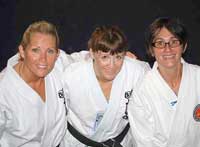Karate
Plays Central Role in Life of Faculty Artist
To Paola Ferrario, the Harnish Visiting Artist at Smith,
her two passions of photography and karate have more in common
than might seem obvious.

Paola Ferrario (right) with her Team USA members, Lorri
Leach (left) and Linda Crimmons. |
Both disciplines require a careful, meditative approach
to achieve mastery. Both culminate, in her case, in public
display of her practice. Most importantly, both pastimes
combine technique with art, a fusion of left-brain pragmatism
with right-brain intuition.
It is the last point that Ferrario, who teaches photography
and digital media, most emphasizes as she devotes a balance
of her time and energy to refining her skills as a photographer
and teacher, and as a second-degree black belt karate student,
master and competitor.
Ferrario put her skills to the test recently as a competitor
on Team USA, which competed in the 10th annual Shotokan Karate-do
International Federation (SKIF) World Karate tournament July
21 through 26 in Athens, Greece.
Ferrario, 46, competed
in the Individual Kata Women (45-49 years) category, placing
6th out of 18 competitors. Kata is a competition that judges
individual competitors in performing a series of “forms,” or
karate positions. It does not involve fighting matches
as in other competitions.
“When they called my name for the final competition,
it was a complete surprise,” said Ferrario, who recently
returned to campus. Though the tournament finals were held
a day earlier than scheduled, catching Ferrario mentally
unprepared, “I felt good about my performance,” she
said.
Since age 11, karate has
played an important part in Ferrario’s
life. Growing up in the village of Rho, Italy (near Milano),
she often played in the streets and got into scrapes and
trouble with other children in town. Karate provided her
with a healthy outlet that allowed a release of youthful
aggression, she said.
Also, she has always wrestled
with a natural tendency toward distraction, she said. “Karate allows me to focus and
extend my span of concentration” due to its rhythmic
movement, its meditative, focused demand and balance of left-brain
and right-brain skills.
Ferrario earned her black belt at age 19, but was injured
shortly after. She then obtained her undergraduate and graduate
degrees in art. After traveling in the United States and
Central America and Italy for much of the 1990s, building
her photography portfolio, she returned to her home country
in 2003 and resumed her karate training at the gym in which
she originally learned the martial art.
The following year, Ferrario received a Guggenheim Fellowship
to develop a project on new immigrants in Italy, and remained
there to train for karate competition while producing a documentary.
These days, Ferrario drives
to Longmeadow, Mass., three times a week to train with Sensei
James Shea, in a class with seven other high-level students.
Though her passions of photography and karate require different
disciplinary approaches, there are occasions when Ferrario
can combine both pursuits.
At the recent SKIF tournament,
for example, during down hours, she shot photographs and
video of other competitors and the surroundings, and she
plans to produce a video depicting competitors’ training
regimens in unusual places, such as the upper reaches of
the bleachers.
Because of its emphasis
on spirituality, technique and physicality, karate is not
a discipline only for the young, Ferrario points out. “The philosophy of karate is not only a sport,
but an art,” she said. “So you continue to get
better as you age.”
Next year, Ferrario plans to compete in the Pan-American
Cup games. In her mid-40s, she says, she is at her peak.
|























